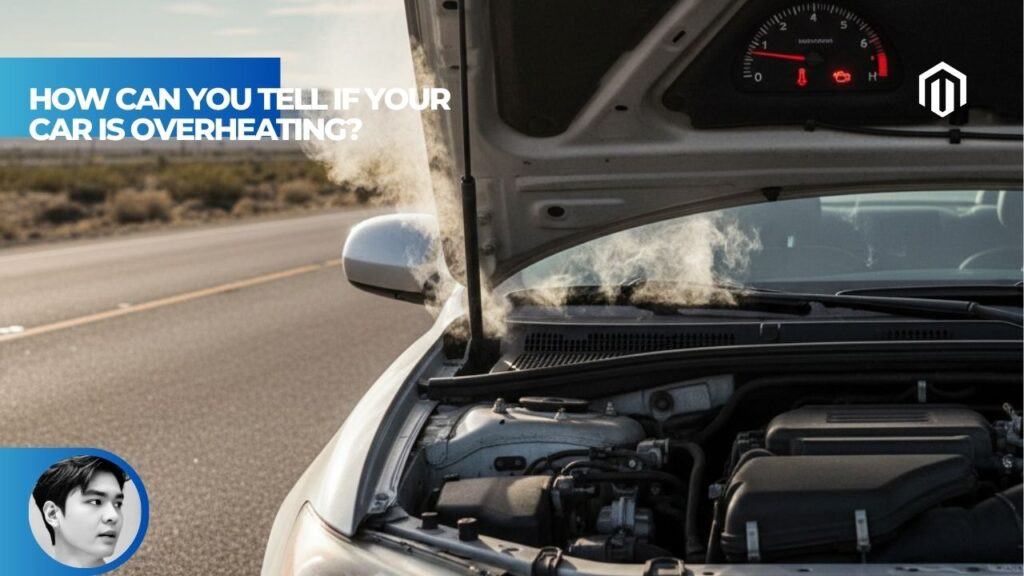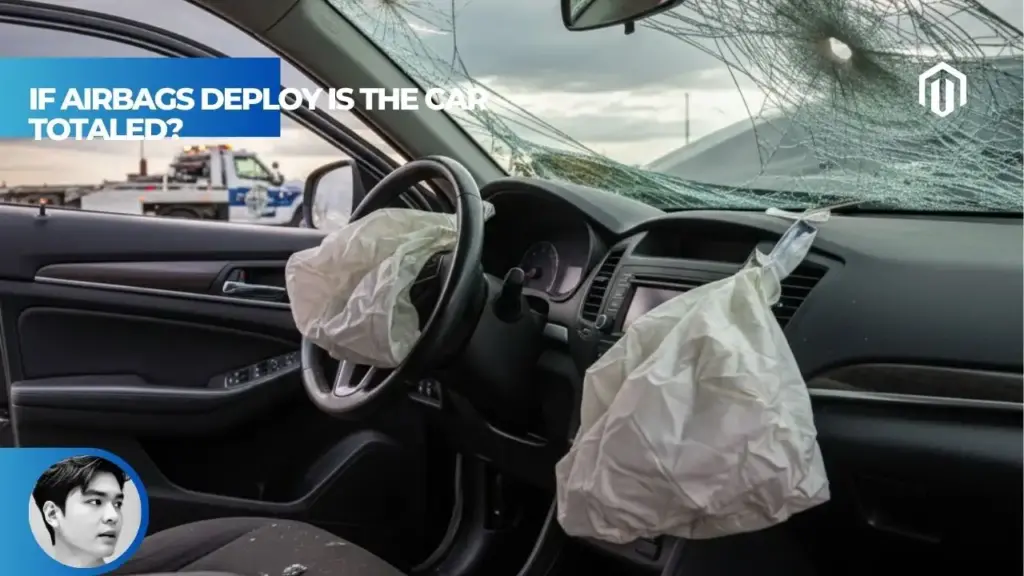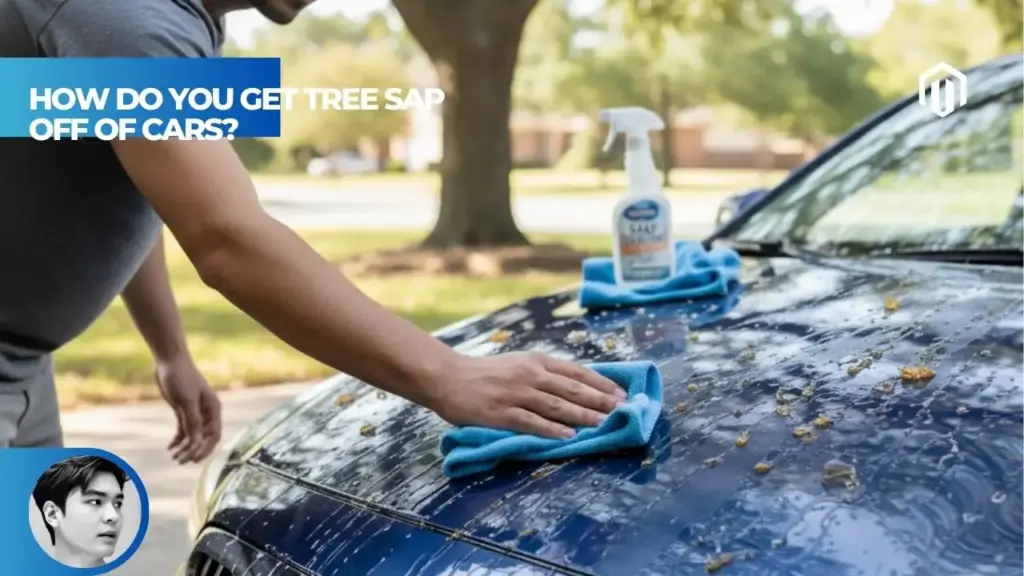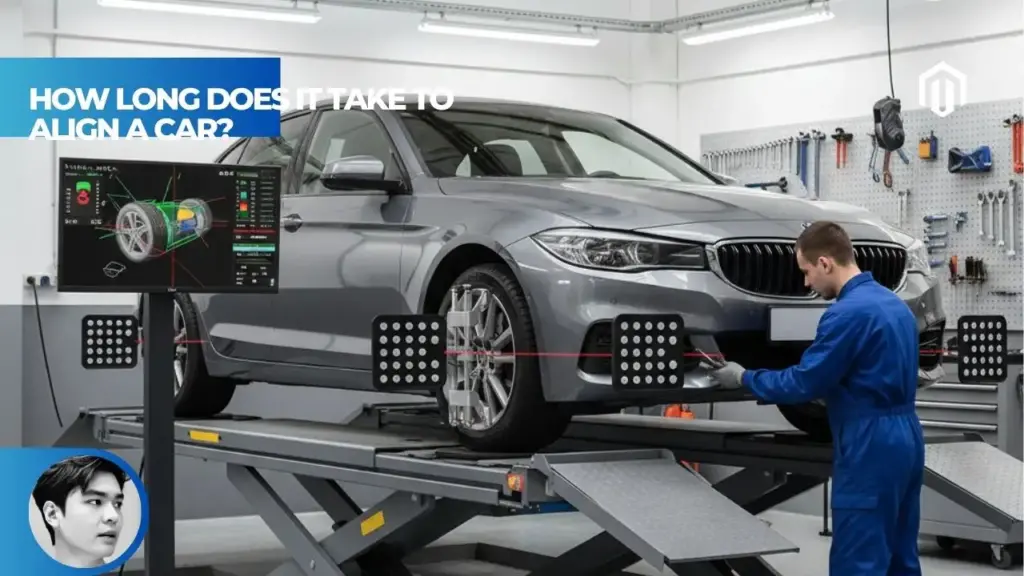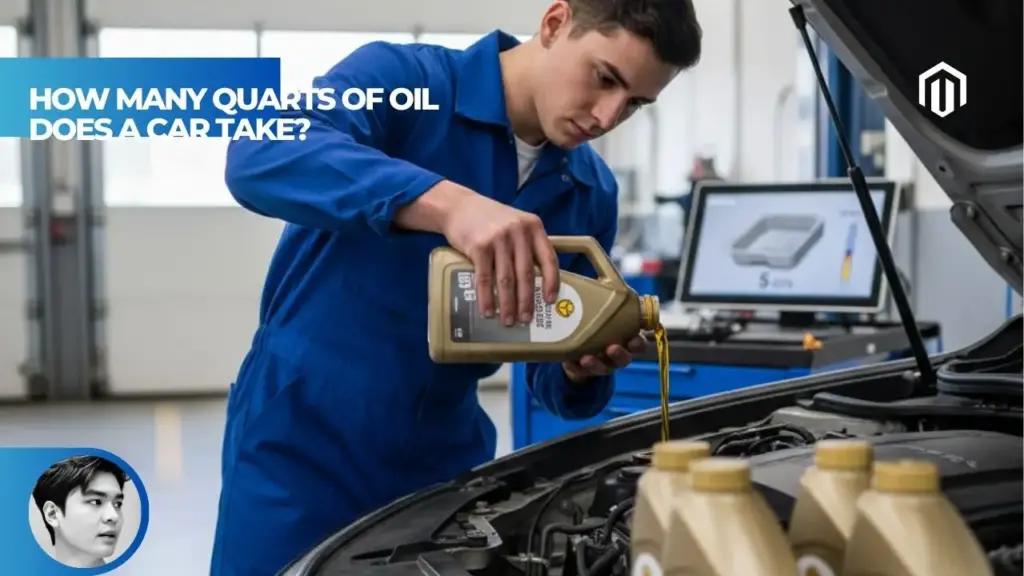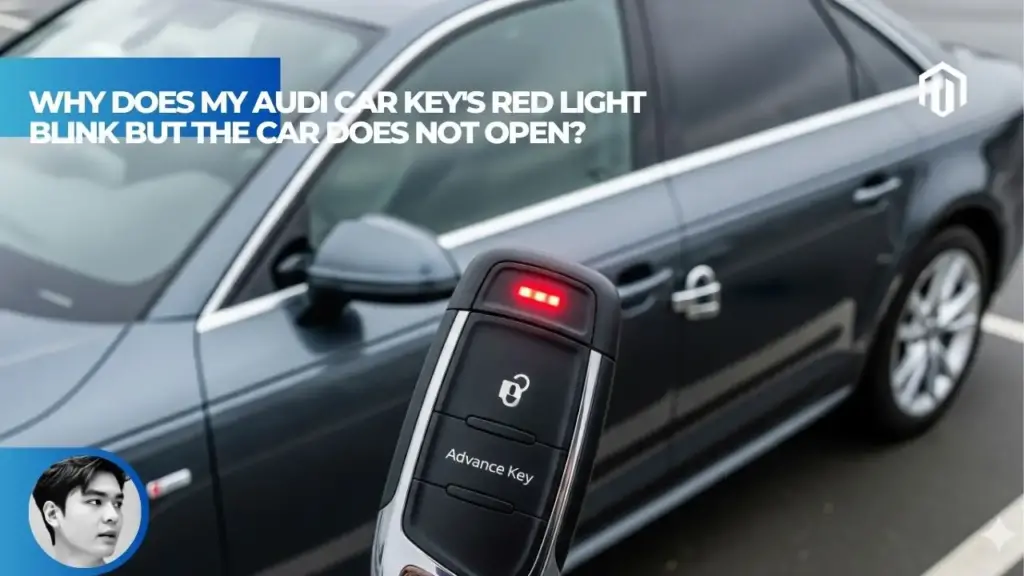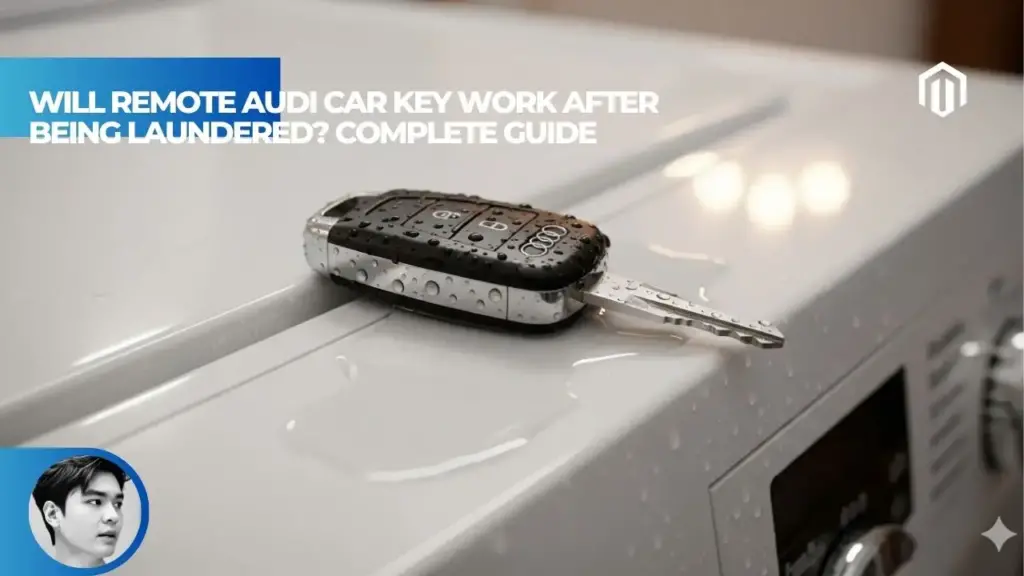You may also like:
- 【Explained】How Long Does It Take a Car to Cool Down? (The 30-Minute to 3-Hour Guide)
- 【Explained】What Engine Does the BMW i8 Have? Full Hybrid Powertrain Explained
- 【Explained】What Coolant Can I Use for BMW? (The G48 Blue vs. HT-12 Green Guide)
- 【Explained】What Does a Car Air Filter Do? Your Guide to Engine Health
- 【Explained】Why Does My Car Smell Like Gas but Isn’t Leaking?
You can tell your car is overheating when the temperature gauge moves into the red zone or “H” mark, steam rises from under the hood, you smell sweet antifreeze or burning oil, and unusual engine noises like ticking or clanking emerge from the engine bay. These warning signs require immediate action—pulling over safely and shutting off the engine—to prevent catastrophic damage that can cost $1,500-$6,000 in repairs[1].
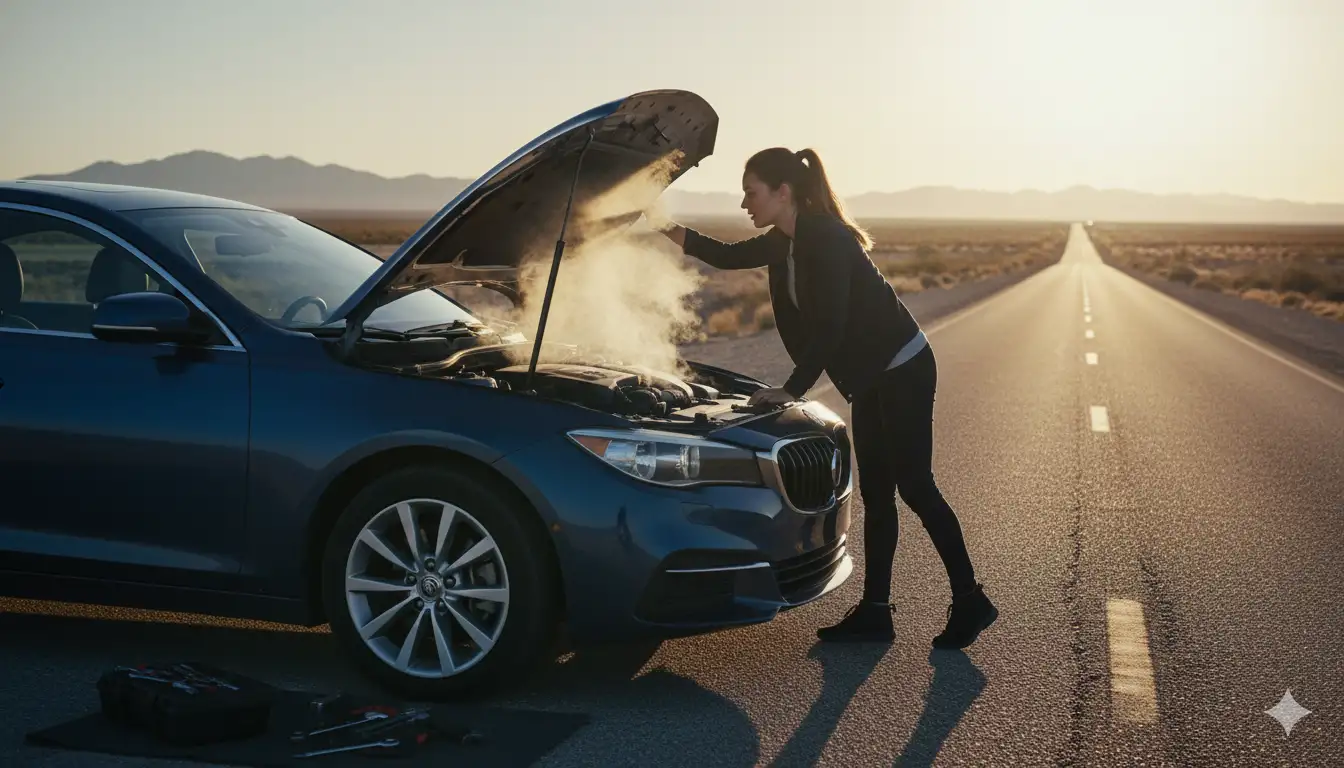
Dashboard Indicators of Engine Overheating
Your dashboard serves as the primary communication center between your car’s engine and you as the driver. Modern vehicles incorporate sophisticated monitoring systems that detect temperature anomalies before serious damage occurs. Understanding these dashboard signals provides the earliest warning of overheating problems, often giving you precious minutes to react before costly engine damage happens.
Temperature Gauge in Red Zone
The temperature gauge represents your most reliable real-time indicator of engine heat levels. This analog or digital display typically shows a needle that moves between “C” (cold) and “H” (hot), with the normal operating range falling in the middle[2]. When functioning properly, this gauge should settle into a consistent position after your engine warms up, usually taking 5-10 minutes of driving.
Reading Temperature Warning Signs
Normal engine operating temperature ranges from 195-220°F for most vehicles, though some performance models run slightly hotter[3]. Your temperature gauge translates these readings into an easy-to-understand visual format. The needle should remain relatively stable during normal driving conditions, perhaps moving slightly during hard acceleration or when climbing steep hills.
When the needle creeps past the three-quarter mark toward “H” or enters the red zone, your engine has exceeded safe operating temperatures. This movement often happens gradually over several minutes, though severe cooling system failures can cause rapid temperature spikes. According to Autvex diagnostic experts, drivers have approximately 30-60 seconds to react once the gauge enters the red zone before serious damage begins.
Check Engine Light On
The check engine light illuminates for numerous reasons, but when combined with temperature gauge readings, it specifically indicates overheating-related issues. Modern engine control modules monitor coolant temperature through multiple sensors, triggering the check engine light when readings exceed programmed thresholds[4].
Common overheating-related diagnostic codes include:
- P0217: Engine overheating condition
- P0128: Coolant temperature below thermostat regulating temperature
- P0116: Engine coolant temperature sensor range/performance
- P0115: Engine coolant temperature sensor circuit
These codes help mechanics quickly identify whether the overheating stems from actual high temperatures or faulty sensors providing incorrect readings.
Warning Lights and Dashboard Alerts
Beyond the traditional temperature gauge, modern vehicles employ multiple warning systems to alert drivers of cooling system problems. These redundant systems ensure drivers receive notification even if they miss initial temperature gauge movements.
Temperature Warning Light Indicators
The dedicated temperature warning light—typically depicted as a thermometer floating in liquid—illuminates when coolant temperature exceeds safe limits. This light often appears red or amber depending on severity, with red indicating immediate danger requiring instant action[2]. Some vehicles display text warnings like “Engine Temperature High” or “Coolant Temp” on digital displays.
Warning light activation thresholds:
| Temperature Range | Warning Type | Required Action |
|---|---|---|
| 230-240°F | Amber warning | Reduce speed, monitor closely |
| 240-250°F | Red warning | Pull over immediately |
| Above 250°F | Flashing red | Shut off engine instantly |
| Above 260°F | Multiple warnings | Severe damage occurring |
Luxury vehicles like the BMW 3 Series and Audi A4 incorporate predictive warning systems that alert drivers before temperatures reach critical levels, providing more reaction time.
Visual and Olfactory Clues of Overheating
Physical manifestations of overheating often provide unmistakable evidence that your cooling system has failed. These sensory warnings typically appear after dashboard indicators, representing more advanced stages of overheating that demand immediate response.
Steam from Engine Coming from Hood
Steam billowing from under your hood represents one of the most dramatic and recognizable signs of engine overheating. This occurs when coolant reaches its boiling point—typically around 212°F at sea level but higher under pressure—and escapes through the radiator cap pressure relief valve or system leaks[5].
Steam or Smoke Recognition
Distinguishing between steam and smoke proves crucial for proper diagnosis and safety response. Steam from overheating appears white or light gray, dissipates quickly in air, and carries a sweet antifreeze smell. Smoke from oil or electrical fires appears darker, lingers longer, and produces acrid burning odors.
Visual identification guide:
- White vapor that disappears quickly = Steam from coolant
- Blue-gray smoke that lingers = Burning oil
- Black smoke with particles = Combustion or rubber burning
- Wispy white continuous stream = Head gasket failure
Steam typically emerges from the front of the vehicle near the radiator or from under the hood edges. The volume increases with engine speed as the water pump circulates more hot coolant through the compromised system.
Unusual Smells from Car
Your nose often detects overheating problems before visual symptoms appear. Different odors indicate specific failures within the cooling system or related components affected by excessive heat.
Sweet Smell from Car (Coolant)
The characteristic sweet, syrupy smell of antifreeze indicates coolant leaking onto hot engine components where it vaporizes. Ethylene glycol, the primary ingredient in most coolants, produces this distinctive maple syrup-like odor when heated[6]. This smell often penetrates the cabin through the ventilation system, providing early warning of developing leaks.
Modern coolants contain different chemical compositions that produce varying scents:
- Traditional green coolant: Sweet, syrupy smell
- Orange DexCool: Slightly sweet with chemical undertone
- Blue/pink extended life: Mild sweet smell, less pronounced
- Yellow hybrid coolant: Almost odorless until very hot
The intensity of coolant smell correlates with leak severity. Faint occasional whiffs suggest minor seepage, while strong persistent odors indicate substantial coolant loss requiring immediate attention.
Burning Oil Smell
When engines overheat, oil breaks down and loses viscosity, potentially leaking past worn seals onto exhaust components. This creates an acrid, thick burning smell distinctly different from coolant’s sweetness[7]. Oil temperatures exceeding 250°F accelerate oxidation, producing a burnt toast odor even without external leaks.
Overheating can cause oil to leak from:
- Valve cover gaskets weakened by heat
- Oil pan gaskets dried and cracked
- Front or rear main seals expanded beyond tolerance
- Oil cooler lines if equipped
This burning oil smell often accompanies blue smoke from the tailpipe, indicating internal engine damage has begun.
Coolant Leak Signs
Coolant leaks represent both a cause and symptom of overheating, creating a destructive cycle where lost coolant reduces cooling capacity, causing higher temperatures that worsen leaks.
Colored Puddles Under Vehicle
Fresh coolant appears bright and translucent, making ground puddles easily identifiable. The color depends on coolant type: traditional green, orange DexCool, pink or blue extended life formulations, or yellow hybrid variants[8]. These puddles typically form under the front of the vehicle where most cooling system components reside.
Puddle location diagnosis:
- Center front: Radiator or hose leak
- Passenger side: Heater core or hoses
- Near wheels: Overflow tank or upper hoses
- Under engine center: Water pump or freeze plugs
- Rear of engine: Head gasket or intake manifold
Fresh coolant feels slippery between fingers and tastes sweet (though never taste it due to toxicity). Dried coolant leaves chalky white or colored residue on pavement. According to Autvex maintenance data, even small leaks losing 1 ounce daily can cause overheating within weeks as the system gradually empties.
Performance and Sound Changes
Engine overheating affects multiple systems simultaneously, creating cascading performance degradation and unusual sounds. These symptoms often appear subtly at first, becoming pronounced as temperatures climb beyond safe thresholds.
Reduced Engine Performance Issues
Heat-soaked engines cannot maintain optimal combustion conditions, resulting in noticeable power loss and drivability problems. Modern engine management systems actively reduce power output to prevent damage when detecting high temperatures.
Vehicle Performance Issues
The engine control module initiates “limp mode” when coolant temperatures exceed approximately 240°F, severely restricting throttle response and maximum RPM[9]. This protective strategy prevents further temperature increases but makes the vehicle barely driveable, often limiting speed to 25-35 mph.
Performance degradation manifests through:
- Sluggish acceleration despite pressing the gas pedal
- Rough idle with noticeable vibration
- Misfiring under load conditions
- Stalling at stop lights or low speeds
- Transmission problems in automatic vehicles
These symptoms worsen progressively as temperatures rise, with complete power loss occurring when the engine computer shuts down cylinders to prevent catastrophic failure.
Loss of Power and Hesitation
Pre-ignition and detonation—commonly called “knock”—occur when excessive heat causes fuel to ignite prematurely in cylinders. This creates opposing forces as pistons rise against expanding gases, robbing power and potentially damaging internal components[10].
Drivers experience this as:
- Hesitation when accelerating from stops
- Surging sensation at steady speeds
- Inability to maintain highway speeds
- Engine seeming to “fight itself”
- Jerking during gear changes
Power loss becomes more pronounced under load conditions like climbing hills or towing, where engines work harder and generate additional heat.
Unusual Engine Noises
Overheating engines produce distinctive sounds as metal components expand beyond design tolerances and lubricants lose effectiveness. These noises provide audible warnings of impending failure.
Ticking Engine Noise
The rhythmic ticking or clicking sound from overheated engines typically indicates oil thinning beyond effective lubrication capacity. As oil temperature exceeds 250°F, viscosity drops dramatically, allowing metal components to contact each other[11]. This valve train noise increases with engine speed, becoming rapid machine-gun-like clicking at higher RPMs.
Common sources of heat-related ticking include:
- Hydraulic lifters starved of proper oil pressure
- Rocker arms lacking cushioning oil film
- Timing chain tensioners losing hydraulic pressure
- Fuel injectors struggling with vapor lock
This ticking often disappears temporarily after cooling, only to return quickly as temperatures rise again.
Clanking and Clicking Sounds
Deeper metallic clanking indicates more severe internal distress than surface ticking. These sounds suggest major components like connecting rods or main bearings suffer from heat expansion and inadequate lubrication. Each “clank” represents potential permanent damage occurring with every engine rotation.
Sound identification by severity:
| Sound Type | Frequency | Location | Severity | Likely Cause |
|---|---|---|---|---|
| Light ticking | Rapid, rhythmic | Top of engine | Moderate | Valve train |
| Heavy clicking | Engine speed dependent | Middle engine | Serious | Rod bearings |
| Deep knocking | Irregular | Lower engine | Critical | Main bearings |
| Grinding | Constant | Throughout | Severe | Multiple failures |
These sounds often accompany visible engine shaking as internal components lose proper clearances.
AC Stops Working
Air conditioning systems interconnect with engine cooling systems, making AC failure an unexpected indicator of overheating problems. When engine temperatures rise excessively, the climate control system sacrifices cabin cooling to reduce engine load.
Heater Blowing Cold Air
Paradoxically, the heater blowing cold air when set to hot indicates insufficient coolant circulation through the heater core. This small radiator inside your dashboard requires constant hot coolant flow to produce warm air[12]. Low coolant levels or air pockets prevent proper flow, eliminating heating capability.
This symptom often appears before complete overheating because the heater core sits higher than engine cooling passages. Air pockets collect here first, providing early warning of coolant loss. Drivers noticing sudden heating loss should check coolant levels immediately.
The AC compressor automatically disengages when coolant temperatures exceed approximately 230°F to reduce engine load. This protective measure eliminates additional heat generation from AC operation but leaves occupants without cooling precisely when ventilation becomes most critical.
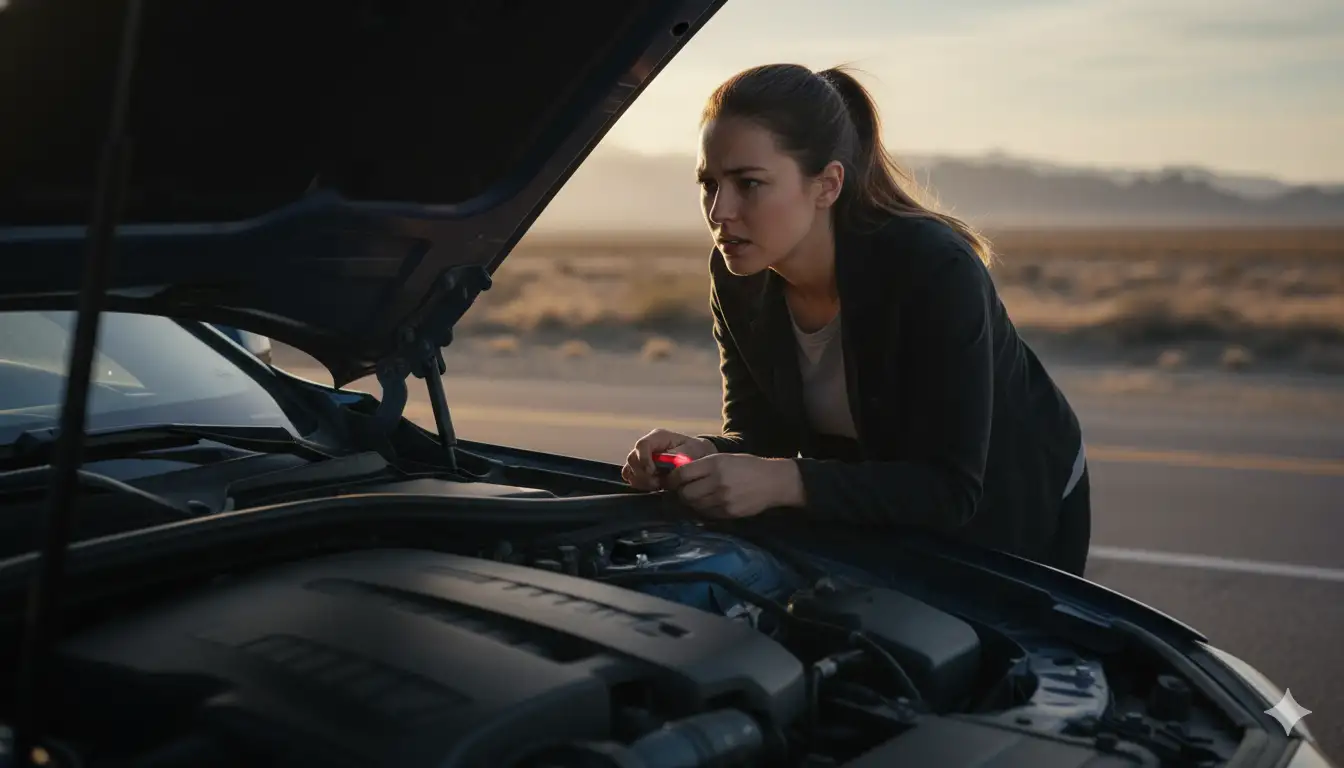
Immediate Warning Signs to Never Ignore
Certain overheating symptoms demand instant response regardless of circumstances. Ignoring these critical warnings virtually guarantees expensive engine damage or complete failure.
First Signs of Car Overheating
Early detection prevents most overheating damage, making recognition of initial symptoms crucial. The first signs often appear subtle, easily dismissed as temporary anomalies by inexperienced drivers.
Progressive warning timeline:
- 0-2 minutes: Temperature gauge creeping above normal
- 2-5 minutes: Gauge approaching three-quarter mark
- 5-7 minutes: Sweet smell becoming noticeable
- 7-10 minutes: Performance degradation beginning
- 10-12 minutes: Steam wisps visible
- 12-15 minutes: Warning lights illuminating
- Beyond 15 minutes: Severe damage occurring
Professional mechanics report that 80% of catastrophic failures could be prevented if drivers responded to initial warning signs rather than continuing to drive[2].
Car Warning Signs Priority
Not all warning signs carry equal urgency. Understanding which symptoms indicate immediate danger versus developing problems helps drivers make appropriate response decisions.
Critical (stop immediately):
- Temperature gauge in red zone
- Steam billowing from hood
- Multiple warning lights
- Loud knocking sounds
- Complete power loss
Serious (stop within 1 mile):
- Temperature gauge above 3/4
- Sweet smell strong in cabin
- Ticking or clicking sounds
- Reduced power noticed
- AC suddenly stops
Developing (monitor closely):
- Temperature slightly elevated
- Occasional coolant smell
- Heater effectiveness reduced
- Minor performance changes
Auto Emergency Response
When overheating symptoms appear, your response speed and actions determine whether you face minor repairs or major engine replacement. Proper emergency response can mean the difference between $200 in repairs versus $6,000 for engine replacement[1].
Immediate action protocol:
- Turn off AC immediately to reduce engine load
- Turn heater to maximum (helps dissipate engine heat)
- Find safe location to pull over
- Shut off engine once stopped
- Pop hood but don’t open fully (allows heat escape)
- Wait minimum 30 minutes before opening hood completely
- Never remove radiator cap while hot (pressurized steam can cause severe burns)
- Call for assistance rather than attempting to drive
For vehicles equipped with engine stop-start technology, disable this feature immediately as repeated restarts can worsen overheating damage.
Cooling System Failure Causes
Understanding why engines overheat helps drivers prevent problems and recognize developing issues before critical failures occur. Most overheating stems from maintenance neglect rather than sudden component failure.
Radiator Fan Not Working
Electric cooling fans should activate when coolant temperature reaches approximately 200-220°F or when AC engages[5]. Failed fans cause overheating particularly in stop-and-go traffic where airflow cannot provide passive cooling.
Fan failure indicators:
- Overheating only in traffic, normal on highway
- No fan sound when AC activated
- Temperature drops immediately when moving
- Visible fan blades not spinning when hot
Fan failures result from:
- Blown fuses or relays ($10-30 fix)
- Failed temperature sensors ($50-100)
- Broken fan motors ($150-300)
- Wiring problems ($100-500)
Modern vehicles like BMW X3 models use variable-speed fans that can partially fail, running but not reaching full cooling capacity.
Low Coolant Symptoms
Coolant loss remains the leading cause of overheating, responsible for approximately 60% of cooling system failures[8]. Even small leaks eventually empty the system, eliminating heat transfer capability.
Progressive symptoms of coolant loss:
- Overflow tank below “MIN” mark
- Heater effectiveness declining
- Temperature fluctuations increased
- Gurgling sounds from dashboard
- Sweet smell intermittent
- Temperature spikes in traffic
- Steam from overflow tank
- Complete overheating
Regular coolant level checks during routine vehicle inspections prevent most overheating incidents.
Car Engine Problems Related to Heat
Chronic overheating creates cascading failures throughout the engine. Metal components warp, gaskets fail, and clearances change permanently when exposed to excessive temperatures.
Heat-related engine damage progression:
| Temperature | Duration | Damage Type | Repair Cost |
|---|---|---|---|
| 240-250°F | 5-10 min | Gasket degradation | $200-500 |
| 250-260°F | 5 min | Head gasket failure | $1,500-2,500 |
| 260-270°F | 2-3 min | Cylinder head warping | $2,000-3,500 |
| Above 270°F | 1-2 min | Engine block damage | $3,000-6,000 |
These figures from recent repair data show how quickly costs escalate with temperature and duration[1].
What to Do When Car Overheats
Your response when detecting overheating determines whether you face minor inconvenience or major repairs. Proper actions can prevent thousands in damage while ensuring personal safety.
Initial Action Steps
The moment you notice overheating signs, begin immediate damage control procedures. Every second counts when temperatures exceed safe limits.
Emergency cooling procedure:
- Reduce engine load: Shift to neutral when safe, avoid acceleration
- Increase heat dissipation: Set heater to max, open windows
- Find safe stopping location: Avoid highways or busy intersections
- Position for visibility: Use hazard lights, deploy triangles if available
- Engine shutdown: Turn key to off, not accessory position
- Battery disconnect consideration: For severe overheating with electrical smells
- Hood ventilation: Pop latch but don’t fully open for 30+ minutes
- Professional assistance: Call roadside service or trusted mechanic
Never attempt to continue driving once severe overheating occurs. The additional cost of towing pales compared to potential engine replacement expenses.
Safety Precautions While Driving
If overheating develops while driving and immediate stopping proves impossible, specific techniques minimize damage while reaching safety.
Survival driving techniques:
- Minimize load: Coast when possible, gentle acceleration only
- Maximize cooling: Heater on full, all vents open
- Speed management: Maintain steady 35-45 mph if possible
- Gear selection: Use lower gears to reduce strain
- Route planning: Avoid hills, choose level roads
- Traffic strategy: Stay in right lane for emergency stopping
- Distance awareness: Note locations of service stations
- Communication: Call ahead to alert repair shop
Studies indicate engines can survive an additional 2-3 miles of careful driving when these techniques are employed, often enough to reach safety[11]. However, this remains extremely risky and should only be attempted when stopping presents greater danger.
For those facing cooling system issues, understanding vehicle damage assessment helps determine whether repairs remain economical.
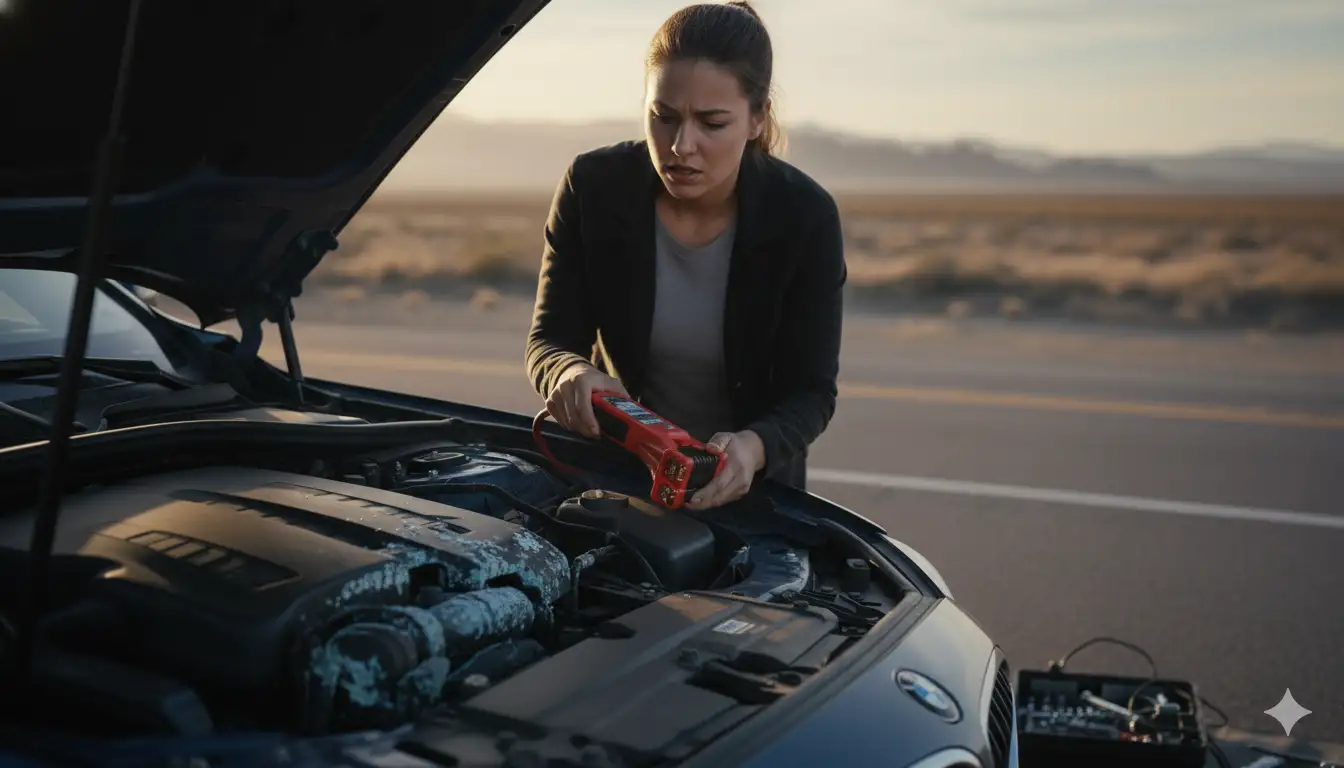
Key Takeaway
You can identify car overheating through multiple warning signs: dashboard temperature gauges entering red zones, steam rising from the hood, sweet antifreeze or burning oil smells, unusual ticking or knocking sounds, and sudden performance loss or AC failure. These symptoms require immediate response—safely pulling over and shutting off the engine within 30-60 seconds—to prevent catastrophic damage that costs $1,500-$6,000 in repairs versus $200-$500 for early intervention[1]. According to Autvex automotive experts, recognizing and responding to the earliest warning signs prevents 80% of major engine failures caused by overheating.
Next Steps
When you detect any overheating symptoms, immediately turn off the AC, activate maximum heat to help dissipate engine temperature, and safely pull over to the roadside within one mile. After stopping, shut off the engine completely and wait at least 30 minutes before opening the hood to avoid steam burns from the pressurized cooling system. Call professional roadside assistance or a trusted mechanic rather than attempting to drive further, as continuing operation risks warping cylinder heads ($2,000-3,500 repairs) or cracking engine blocks ($3,000-6,000 replacement). Schedule regular cooling system maintenance including coolant flushes every 30,000 miles and annual inspections of hoses, belts, and fans to prevent future overheating incidents.
FAQs
What does an overheating engine sound like?
An overheating engine produces distinct ticking, clicking, or knocking sounds as metal components expand and oil loses viscosity from excessive heat above 250°F[11]. Light rhythmic ticking indicates valve train problems, while deeper knocking suggests serious bearing damage requiring immediate engine shutdown.
What are the first signs of a car overheating?
The first signs include the temperature gauge creeping above normal position toward 3/4 mark, faint sweet antifreeze smell entering the cabin, slight reduction in engine performance, and heater effectiveness declining[2]. These early warnings typically appear 5-10 minutes before critical overheating.
How can you tell if your car is overheating while driving?
While driving, monitor your temperature gauge approaching the red zone, notice any sweet coolant smell or burning odors, feel power loss during acceleration, observe steam wisps from the hood, and watch for warning lights illuminating on the dashboard[3].
What happens if you ignore an overheating engine?
Ignoring overheating causes progressive damage: head gasket failure at 250°F ($1,500-2,500), warped cylinder heads at 260°F ($2,000-3,500), and cracked engine blocks above 270°F requiring complete engine replacement ($3,000-6,000)[1].
Can a car overheat without the temperature gauge going up?
Yes, if the temperature sensor fails, coolant level drops below sensor reach, or electrical problems prevent gauge operation, engines can overheat without dashboard indication[4]. Watch for other symptoms like steam, smells, or performance loss.
Is it okay to drive a little with an overheating car?
No, driving even short distances with an overheating engine risks catastrophic damage within minutes as temperatures above 250°F cause immediate head gasket failure and permanent warping[11]. Pull over immediately and shut off the engine.
What do you do immediately if your car starts to overheat?
Turn off AC, set heater to maximum, safely pull over within one mile, shut off engine completely, wait 30+ minutes before opening hood, and call for professional roadside assistance rather than attempting repairs[2].
How can I tell if my coolant is low?
Check the transparent overflow reservoir for levels below “MIN” mark, notice reduced heater effectiveness, hear gurgling sounds from the dashboard, see puddles under the vehicle, or observe temperature gauge fluctuations during normal driving[8].
References
- Jerry.ai. (2025). How Much Will it Cost to Fix an Overheated Engine? Retrieved from https://jerry.ai/car-repair/how-much-does-it-cost-to-fix-an-overheating-car/
- Severson Auto Service. (2025). 5 Car Overheating Warning Signs You Should Never Ignore. Retrieved from https://www.seversonautoservice.com/5-car-overheating-warning-signs-you-should-never-ignore
- Telle Tire. (2025). Safely Diagnose an Overheated Car Engine. Retrieved from https://www.telletire.com/blog/why-is-my-car-overheating/
- Auto Science. (2024). 5 Warning Signs of a Cooling System Problem. Retrieved from https://www.autoscience.com/5-warning-signs-of-a-cooling-system-problem
- Spectrum Auto. (2025). 4 Common Warning Signs that You Need Cooling System Repair. Retrieved from https://www.spectrumautogilbert.com/4-common-warning-signs-that-you-need-cooling-system-repair
- CRC Industries. (2025). How Much Does a Coolant Leak Repair Cost for a Car. Retrieved from https://www.crcindustries.com/blog/coolant-leak-repair-cost-car/
- Four Car Garage. (2024). Can Overheating Damage My Car’s Engine and How Can I Avoid It. Retrieved from https://www.fourcargarage.com/blog/can-overheating-damage-my-car-s-engine-and-how-can-i-avoid-it
- Heath’s Auto Repair. (2025). How Much Does It Cost To Fix A Coolant Leak 2025. Retrieved from https://heathsautorepairprescott.com/how-much-does-it-cost-to-fix-a-coolant-leak/
- Endurance Warranty. (2025). What Causes Engine Overheating? Retrieved from https://www.endurancewarranty.com/learning-center/expert-auto-tips/engine-overheating-causes/
- 10K Wraps. (2025). What to Do When Your Car Engine Overheats in 2025. Retrieved from https://10kwraps.com/blog-what-to-do-when-your-car-engine-overheats-in-2025/
- 5 Star Auto Service. (2025). How Long Is It Safe to Drive When My Car Overheats. Retrieved from https://www.5starautoservice.com/blog/how-long-is-it-safe-to-drive-when-my-car-overheats
- Firestone Complete Auto Care. (2019). What to Do (& Not Do) When Your Car Overheats. Retrieved from https://www.firestonecompleteautocare.com/blog/maintenance/when-car-overheats/

I am a senior automotive analyst at Autvex. Expert vehicle evaluations, in-depth reviews, and objective analysis helping readers make informed automotive decisions with years of industry experience.

